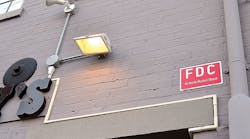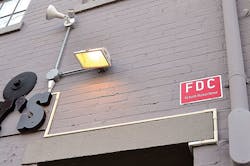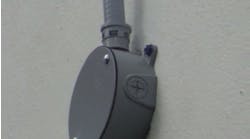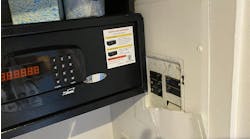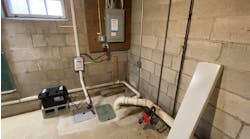All references are based on the 2017 edition of the NEC.
Installer is “Wet Behind the Ears”
The rules explaining the specific wiring methods permitted for exterior wiring on buildings or structures could not be made any clearer. Section 225.10 features a list of 19 permitted wiring methods. Surface metal raceway is not on the list. It simply should not have been used in this location. Likewise, although Sec. 386.10 gives permission to use surface metal raceways in dry locations, it never gives permission to install it in wet locations like this exterior wall.
Section 225.22 requires exterior raceways to be listed or approved for wet locations. The electrical metallic tubing (EMT) installed on the upper portion of this wall may be listed for wet locations, but the surface metal raceway certainly is not. Additionally, the set screw connectors installed on the EMT are not listed for use in this wet location, as required by Sec. 314.15.
With all of these “wet location” violations, I wonder if the conductors installed inside the raceways are designed to be installed in this aboveground wet location. I tend to think not. Section 300.9 tells us that the inside of these raceways is also considered a wet location, and any installed insulated conductors must comply with the requirements of Sec. 310.10(C).
Separation Anxiety
This is a great example of what not to do when installing wiring methods under metal-corrugated sheet roof decking. In this instance, the installer placed the raceway (and the wiring in it) in harm’s way by placing it where long screws used during roofing repairs could penetrate it. In fact, it was a really close call for this PVC conduit. A few screws came dangerously close to penetrating the raceway.
Section 300.4(E) requires cables, raceways, and boxes to be installed with a minimum of 1½ in. between the lowest portion of roof decking and the top of the cable, raceway, or box. An Exception allows rigid metal conduit (RMC) and intermediate metal conduit (IMC) to be installed without the required 1½ in. of spacing. For luminaires, Sec. 410.10(F) requires the same 1½ in. of separation between the bottom of the roof decking and the top of the luminaire.
On a different note, the lack of support for the NM cable entering the metal junction box is a violation of Sec. 334.30, which requires NM cable to be supported within 12 in. of the box and at intervals not exceeding 4½ ft.
